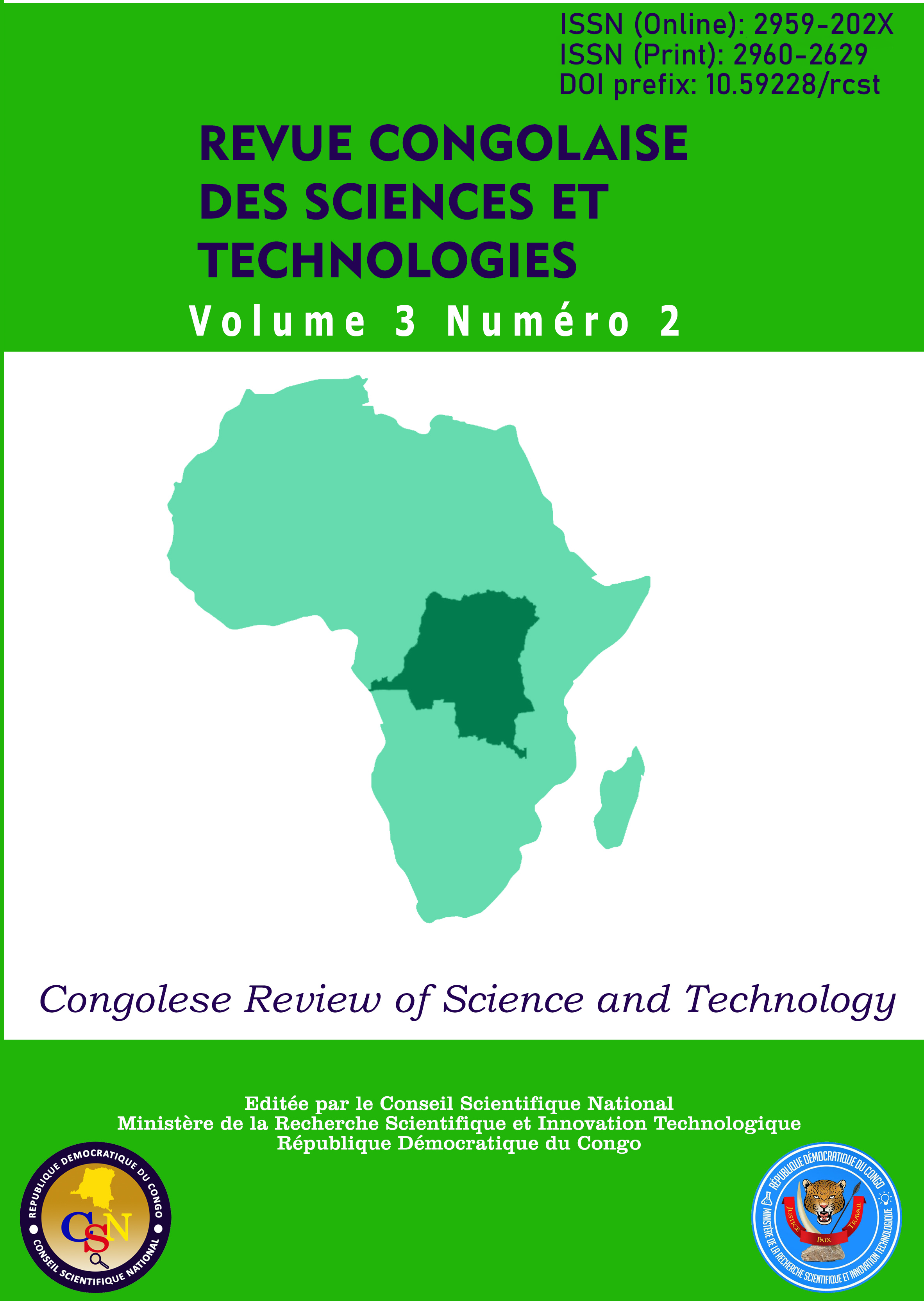Isolation of bacteria in the aseptic surgery and neonatology rooms of the Ngaliema Clinic and the King Beaudoin I Hospital of Masina in Kinshasa, DRC
Main Article Content
Abstract
Surgery and neonatology rooms must be free of all biotamination. The presence of pathogenic bacteria in the environment of these rooms
could lead to infection of patients, resulting in an increase of morbidity and mortality. This study aimed to detect the presence of pathogenic
resistant bacteria to antibiotics in the surgery and neonatology rooms of the Ngaliema Clinic and the King Beaudoin I Hospital of Masina.
Indoor air of the rooms, the swab of the surfaces of the incubators, operating beds and the handles of the doors as well as the nurses' coats
were analyzed. Bacteria were identified by standard bacteriology methods and antibiotic sensitivity was performed by the Müller Hinton agar
medium diffusion method. 21 swabs and 34 air samples were collected. 63 strains of bacterial were isolated among them 30 at the Ngaliema
clinic and 33 at the King Beaudoin I Hospital. The isolated bacteria were Staphylococcus aureus (34.9%), Staphylococcus spp (30.2%),
Bacillus spp (12.7%), Klebsiella pneumoniae (9.5%), Pseudomonas spp (7.90%), Klebsiella ozaenae (1.6%), Providencia alcalifaciens
(1.6%) and Acinetobacter spp (1.6%). 52.2% of strains were multi-resistant to the majority of antibiotics tested. The results of the present
study showed that multi-resistant bacteria are circulating in the neonatology and surgery rooms of these hospitals. Infection prevention and
control measures should be considered.
Article Details

This work is licensed under a Creative Commons Attribution-NonCommercial-ShareAlike 4.0 International License.
References
Afle, F., Kisito J.M.K., Hessou, S., Johnson, R.C.
(2018). État des lieux des infections associées
aux soins dans deux hôpitaux publics du sud
Benin (Afrique de l’ouest) : Centre Hospitalier
Universitaire de Zone d’Abomey- Calavi/SôAva et Centre Hospitalier de Zone de Cotonou
Journal of Applied
Biosciences. 121(1),12192.
Aketi, L. & Malembi, M. (2015). Profil épidémioclinique et bactériologique des infections
bactériennes au Département de Pédiatrie des
Cliniques Universitaires de Kinshas a. Anales
Africaines de Médecine. 8(2).
Andriananivelo, A.M., Rafaravavy, N.E.,
Rafalimanana, C., Andriantahiana, T.N.,
Robinson, A.L. (2010). Bacteriological profile
of neonatal infection at the neonatal intensive
care unit of the maternity hospital of
Befelatanana. Revue d’AnesthésieRéanimation et de Medicine d’Urgence. 2(2),
-4.
Ango, P.D, Konan, K.D, Kouamé, K.A., Sai, S.S.,
Tchimou, A.M.Y., Adingra, S.C.E. &
Diomandé, S.E. (2020). Microbial ecology of
surfaces and medical devices in the intensive
care unit of the University Teaching Hospital
of Trechiville. Health Science & Diseasse.
(1), 1-12.
Avril, J.L., Dabernat, H., Denis, F. & Monteil, H.
(1992). Bactériologie clinique (2
ème édition).
Paris, Ellipes.
Biomerieux. (2016). Guide pratique sur le contrôle
des infections environnementales dans leshôpitaux, BIOMERIEUX SA. Consulté le
/02/2023. www.biomerieuxculturemedia.com.
Bukasa, J.C., Muteba, P., Kazadi, A., Lepelletier, D.,
Ilunga, F., Mutombo, A., Ngoyi, K.A.,
Bandimuna, A., Ngoyi, M.S., Wembonyama,
S. (2021). Etude de l´incidence des infections
nosocomiales et facteurs de risque dans les
maternités de la ville de Mbujimayi,
République Démocratique du Congo. Pan
African Medical Journal. 38(95), 1-15.
CA-SFM/EUCAST(Comité de l’Antibiogramme de la
Société Française de Microbiologie/ European
Committee on Antimicrobial Susceptibility
Testing (2023). Détermination de la sensibilité
des bactéries aux antibiotiques : Conditions
techniques pour les méthodes de diffusion.
Recommandation 2023.V.1.0 Juin. Consulté le
/02/2023. https://www.sfmmicrobiologie.org/boutique/comite-delantibiograme-de-la-sfm-casfm/.
El Ayne, S., Nabila, E., Adil, Chaouch, A., Nabila, A,
Hamama, S. & Soulaymani, A. (2014). Rôle de
l’environnement hospitalier dans la prévention
des infections nosocomiales : surveillance de la
flore des surfaces à l’hôpital El Idrissi de
Kenitra – Maroc. European Scientific Journal
(9), 1857 – 1881
Hendrick, M.L., Eric, K., Abdulu, Roger, N.N.,
Suganuma, N., Abel, N.M., Vicky, M., Michel
M. & Françoise, M.K. (2017). Nosocomial
urinary tract and surgical site infection rates in
the Maternity Ward at the General Referral
Hospital in Katuba, Lubumbashi, Democratic
Republic of the Congo. Pan African Medical
Journal, 28(5), 57.
Ouédraogo, S.O., Méda, D., Dao, L., Kouéta, F.,
Ludovic, K., Traoré, R.O. & Yé, D. (2016).
Facteurs associes aux décès des nouveau-nés
suspects d'infections bactériennes au Centre
Hospitalier Universitaire Pédiatrique Charles
de Gaulle de Ouagadougou, Burkina Faso. Pan
Afr Med J. 24(7), 1-6.
Santé Publique France (2017). Rapport annuel 2017.
Consulté le 28/02/2024. https://www.viepublique.fr/rapport/37320-sante-publiquefrance-rapport-annuel-2017.
Société Marocaine d’Infectiologie Pédiatrique et de la
Vaccinologie (SOMIPEV). (2017). Guide
pratique des bactéries pathogènes, SOMIPEV.
www.somipev.ma. Traoré, A.T., Bengaly, L., Giani, S., Kouriba, B. &
Sanogo, R. (2020). Microbiological control of
medical devices, surfaces of operating theatres
and delivery rooms before and after
disinfection with chlorine produced locally in
two Malian University Hospital. Health Sci.
Dis. 21(11), 48-52

